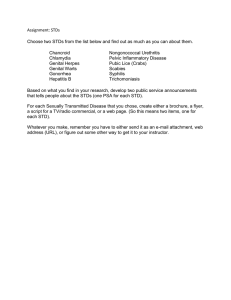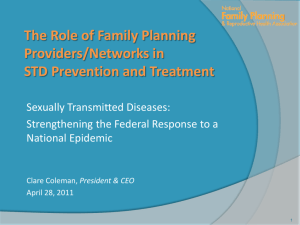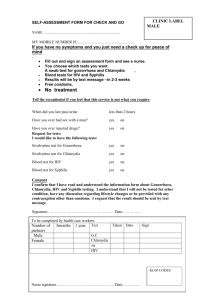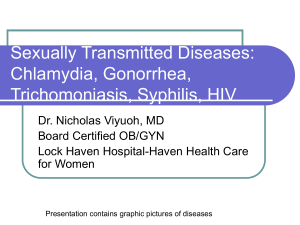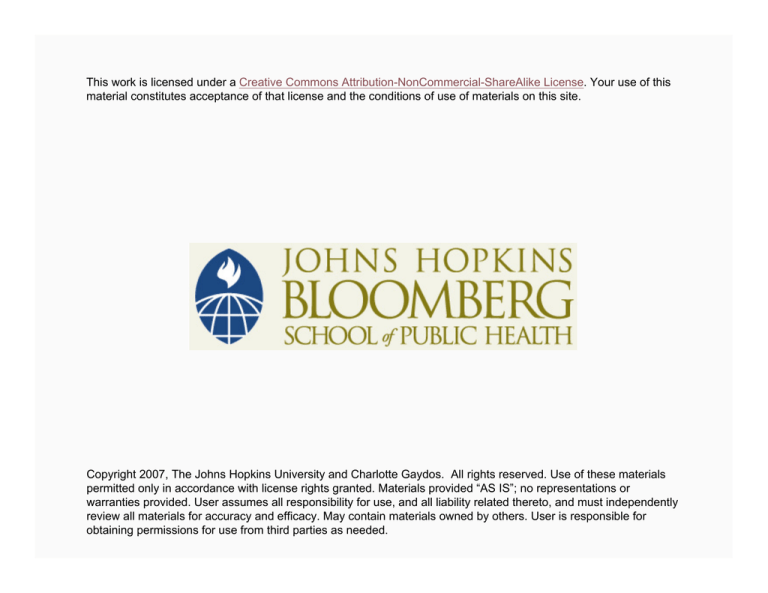
This work is licensed under a Creative Commons Attribution-NonCommercial-ShareAlike License. Your use of this
material constitutes acceptance of that license and the conditions of use of materials on this site.
Copyright 2007, The Johns Hopkins University and Charlotte Gaydos. All rights reserved. Use of these materials
permitted only in accordance with license rights granted. Materials provided “AS IS”; no representations or
warranties provided. User assumes all responsibility for use, and all liability related thereto, and must independently
review all materials for accuracy and efficacy. May contain materials owned by others. User is responsible for
obtaining permissions for use from third parties as needed.
New STD Diagnostics: Effect on Population Based
Surveillance for STDs
Charlotte Gaydos, MS, MPH, DrPH
Johns Hopkins University
Objectives
1.
2.
3.
4.
Review standard methods for diagnosis
Review new molecular diagnostic methods
Discuss standard and rapid tests
Explain the effect new diagnostics has on population based
surveillance
5. Future strategies for STD control
3
Section A
Review Standard Methods for Diagnosis; Review New
Molecular Diagnostic Methods
Requirements for a Diagnostic Assay
High specificity
High PPV and NPV for
all population types
Inexpensive, available
Rapid, simple to perform
High sensitivity
Sophisticated equipment
not required
Sample type convenience
Distinguishes present from
past infection
5
Advantages of Molecular Assays for Diagnosis of STDs
High sensitivity and specificity
Useful with noninvasive specimens (urine, self-administered vaginal
swabs)
Relatively rapid results (within 24 hours)
Stability of specimens vs. culture
Useful for field settings, screening—no clinic, no clinician required
Cost-effective despite expense of assays
Useful for multiple pathogens
6
Organisms
Chlamydia trachomatis and neisseria gonorrhoeae
Trichomonas vaginalis
Mycoplasma genitalium
Rapid tests (point of care diagnostics)
− Chlamydia and gonorrhea
− Trichomonas
− Bacterial vaginosis (BV)
− HSV-1, HSV-2
− Syphilis
− HIV
7
Chlamydia Trachomatis
DFA stain, tissue culture in McCoy cells
EIA (enzyme immunoassay)
Probe Pace 2 (Gen-Probe)
PCR Amplified DNA (Roche)
TMA (transcription mediated amplification)
Amplified RNA (Gen-Probe)
Amplified Signal (Digene)
SDA (strand displacement amplification) (Becton Dickinson)
Robotics
NAATs (nucleic acid amplification tests)
8
Neisseria Gonorrhoeae
Gram stain/culture on Thayer Martin agar
Probe (Pace 2) (Gen-Probe)
PCR Amplified DNA (Roche)
TMA (transcription mediated amplification)
Amplified RNA (GenProbe)
Amplified Signal (Digene)
SDA (strand displacement ampliication) (Becton Dickinson)
Robotics
NAATs (nucleic acid amplification tests)
9
Relative Comparison of Sensitivity of Various Types of
Tests for Detection of Chlamydia or Gonorrhea
Number/ 1
organisms
per sample
10
102
103
104
105
106
107
108
NAAT*
Signal
Amplification Test
Direct Probe Test
Enzyme
Immunoassay
Sensitivity Range/Sample
Notes: *Nucleic Acid Amplification Test
10
Basic Steps in NAATs Nucleic Acid Amplification Tests
Sample preparation (heat, lysis, extract the DNA or RNA) or extract
nucleic acid (NA) robotically
Thermocycling to amplify DNA x 106 copies
− Denaturation, annealing, extension
Detection of amplified DNA product
− Gel
− EIA/colorimetric assay, microparticle, hybridization, probe
11
Sensitivity of Culture and PCR for C. Trachomatis in
Men and Women
N = 1,238
Pos. 55%
Culture
Pos. 90.3%
PCR
12
BDProbeTec™ ET System (SDA)
30 min
Sample
Lysis
Sample
Preparation
15 min
Sample
Cooling
20 min
Priming Well
Incubation
Room Temp
60 min
Amplification and Detection
10 min
Priming and Pre-Warm
Incubation, Transfer
13
APTIMA (TMA)
Target Capture
Removes inhibitors
− Amplification targeting ribosomes
Dual Kinetic Assay (DKA)
− Simultaneous detection/differentiation CT/GC
Transport medium allows shipping and storage at 2° to 30° C
The APTIMA Combo2 is FDA cleared for . . .
− Male and female swab specimens
− Male and female urine specimens
− Symptomatic and asymptomatic patients
− Self and clinician administered vaginal swabs
14
Table 1: Sensitivity and Specificity of Diagnostic Tests
for the Detection of Chlamydia Trachomatis
Diagnostic Method
Tissue Culture
Direct Fluorescent Antibody
Enzyme Immunoassay
Hybridization (Pace2)
Polymerase Chain Reaction
Cervical
Female Urine
Male Urine
Strand Displacement Amplif
Cervical
Female urine
Male urine
Transcription Mediated Amplif
Cervical
Female Urine
Male Urine
Male Urethral
Sensitivity
70-85%
80-85%
53-76%
65-83%
Specificity
100%
>99%
95%
99%
89.7%
89.2%
90.3%
99.4%
99.0%
98.4%
92.8%
80.5%
93.1%
98.1%
98.4%
93.8%
94.2%
94.7%
97.0%
95.2%
97.6%
98.9%
99.1%
98.2%
15
Table 2: Sensitivity and Specificity of Diagnostic Tests
for the Detection of Neisseria Gonorrhoeae
Diagnostic Method
Culture
Gram Stain
Males-symptomatic
Males-asymptomatic
Females
Hybridization (Pace2)
Polymerase Chain Reaction
Cervical
Female Urine
Male Urine
(Symptomatic)
Strand Displacement Amplif
Cervical
Female urine
Male urethral
Male urine
Transcription Mediated Amplif
Cervical
Female Urine
Male Urine
Male Urethral
Sensitivity
80-95%
Specificity
100%
90-95%
50-70%
50-70%
92.1-96.4%
95-100%
95-100%
95-100%
98.8-99.1%
92.4%
64.8%
99.5%
99.8%
94.1%
99.9%
96.6%
84.9%
98.5%
97.9%
98.0-100%
99.3-100%
91.9-100%
92.5-100%
99.2%
91.3%
97.1%
98.8%
98.7%
99.3%
99.2%
98.2%
16
Comparison of Three NAATs in Urines for Chlamydia (N = 506)
Sensitivity
Specificity
ABBOTT
LCR
96.0%
99.1%
BD
ProbeTec
96.0%
100%
GEN-PROBE
Aptima Combo2
100%
98.8%
True positive = 2 positive NAATs
Gaydos, C. JCM (2004); 42: 3041-3045
17
Trichomonas Vaginalis
More prevalent than CT or GC
− Estimates eight million cases annually in the U.S.
− Not a reportable disease
Men—may be asymptomatic (>50%), NCNGGU, may cause prostatitis,
epididymitis; associated with a significant decrease in sperm
motility and viability; isolated from 10% infertile men
Women—asymptomatic (<50%) or cause frothy discharge, risk for
cervical neoplasia, tubal infertility post-hysterectomy infection
atypical PID preterm birth, low birth weight
Risk factor for HIV transmission in men and women (?)
Sensitivity—wet preparation ~50%; culture ~70%
− PCR ~90%
18
Recent Publications
Soper (2004). A J Ob Gyn: Trichomoniasis Review 190: 281-290
Moodley, et al. (2002). CID: TV Associated with PID in HIV+ Women
Zhang, et al. (1994). Int J Epidemiol: TV a Cause of Cervical
Neoplasia (24 studies)
Zhang, et al. (1995). Ann Epidemiol: TV and Cervical Cancer:
Prospective Study in China
Sayed El-Ahl, et al. (2002). J Egypt Soc Parasit: TV and Cervical
Cancer in Egyptian women
Hobbs, et al. (1999). STD: TV Cause Urethritis in Malawian Men
Hardick, et al. JCM (2006): Cf GP TMA TV with Research PCR
19
Mycoplasma Genitalium
Thought to be sexually transmitted
Associated with NCNGGU in men and cervicitis in women recently
Possible sequelae
− Endometritis?
− PID?
− Adverse birth outcomes?
Smallest prokaryote bacteria capable of self-replication; difficult to
culture; PCRs described
20
Recent Publications
Manhart, et al. (2003). JID: M. Gent Assoc with 3.3 Risk MPC
Mena, at al. (2002). CID: M. Gent in 25% of 97 Men Urethritis cf. 7%
Asymptomatic p = .006
Falk, et al. (2004). STI: M. Gent+ Men (7%) Had Sym Urethritis More
Often than Men Infect with CT (12%), 63% Female PN Infected with
M. Gent; 35% of Men w/ Urethritis Had No Agent
Deguchi, et al. (2004). STD: U. Urealyticum in 15.8% Men NGU or
Non-CT Urethritis (18%) CF Men without Urethritis (7.8%)
Jenson, et al. (2004). Urine Better Sample in Men
Dupin, et al. (2003). CID: Real Time PCR 115-kDa Gene, Shift to
Decreasing Bacterial Load or Negative PCR after Rx
Hardick, et al. (2006). JCM: Perfm. GP TMA to PCR for MG
21
Microbial Etiology Study Methods: CT,GC, TV, MG
Men (290) and women (325) attending STD clinics
Urethritis and cervicitis was dx’d; multiple samples
Routine tests—GenProbe Combo2 tests for CT and GC
Trichomonas research PCR*
− B tubulin gene; RT-PCR Roche Light Cycler
Mycoplasma research PCR**
− Two targets in a diplex assay; MgPa adhesion gene
− 16S rRNA gene; 7900 ABI Prism system
− APTIMA TMA*** also performed for trichomonas (AMP-TV) and
for mycoplasma genitalium (AMP-MG)
Sources: *Hardick., J., et al. (2003). JCM; **Hardick, J., et al. (2006). JCM; *** Hardick, A., et al.(2006). JCM
22
Microbial Etiology Study Results: N = 325 Females, 290 Males
Females:
CT*
GC*
TV*
MG*
%
11.4
4.3
14.9
24.6
*Patient Infected Status
TV B-TUB FRET
TMA-TV
MG MLRT PCR
TMA MG
15.7
19.0
20.9**
21.9**
**Based on Resolved MG results
Males:
CT*
GC*
TV*
MG*
%
20.3
12.8
3.9
15.2
*Patient Infected Status
TV B-TUB FRET
TMA-TV
MG MLRT PCR
TMA MG
3.8
4.5
15.7**
17.5**
**Based on Resolved MG results
23
Results: N = 325 Females, 290 Males
Females:
N = 77
Cervicitis
N = 248
18.2% (14/77)
7.8% (6/77)
9.3% (23/248)
3.2% (8/248)
TV
MG
* 2 tests not done
18.2% (14/77)
26.0% (20/77)
13.2% (34/246)*
17.5% (43/246)*
Males:
N= 153
Urethritis
N=137
No Urethritis
32.7% (50/153)
24.2% (37/153)
6.6% (9/137)
0% (0/137)
5.2% (8/153)
21.7% (31/152)**
2.2% (3/137)
8.0% (11/137)
CT
GC
CT
GC
TV
MG
** 1 test not done
No Cervicitis
24
Results: Females with Cervicitis (n = 77)
6%
3%
CT+
13%
GC+CT+
TV+
3%
47%
1%
3%
1%
GC+
CT+TV+
TV+MG+
GC+CT+TV+
MG+
MG+CT+
17%
MG+CT+GC+
No Infection
1%
5%
25
Results Males with Urethritis (n = 153)
17%
CT+
GC+CT+
32%
6%
2%
1%
15%
1%
11%
1%
13%
TV+
GC+
CT+TV+
GC+TV+
MG+
MG+CT+
MG+CT+GC+
MG+TV+
No Infection
1%
26
Association with Cervicitis
Univariate
Multivar Model 1
Model 2
CT
OR
1.95
p value
0.058
OR
1.60
p
0.250
OR
p
1.58 0.078
NG
1.69
0.316
1.01
0.983
0.93 0.911
TV
1.61
0.126
1.59
0.146
1.56 0.174
MG
2.64
0.0006
2.42
0.0026
1.56 0.0028
Age < 25 Years 1.42
Contact
0.62
0.140
0.323
1.21 0.467
0.47 0.858
27
Association with Urethritis
Univariate
Multivariate Model 1
CT
OR
6.9
p value
< 0.0001
OR
6.92
NG*
88.5 < 0.0001
----*
TV
3.72
0.1087
4.29
0.08
MG
3.66
0.000
3.67
0.000
Age < 25 yr 1.1
0.69
Contact
0.05
1.97
Notes: * NG could not be fit into the multivariate model due to collinearity
between NG and urethritis that caused the model not to fit
p
< 0.0001
28
Conclusions
Urethritis and cervicitis cause significant morbidity world wide
Common agents are gonorrhea and chlamydia, but non-chlamydialnon-gonoococcal ureth/cx common
Use of newer tests such as Gen-Probe AMPTIMA for trichomonas and
mycoplasma or PCR will allow better etiologic diagnostic capability
in future studies
It appears that even with increased diagnostic capability, a
significant proportion of urethritis and cervicitis cases yield no
etiologic agent
Reasons—other agents such as HSV, ureplasma, m. hominis, undiscovered organisms, atopobium vaginae? Others?
29
Section B
Standard and Rapid Tests
Summary of New Molecular Tests for CT, GC, TV, MG
All appear to have superior sensitivity and specificity cf. to older
traditional tests
Expense is an issue
They are cost effective and C-E analyses can guide choices
They allow for use of non-invasive specimens and non-traditional
venues
31
Standard and Rapid Tests for STDs
CT/GC
Trichomonas
BV
Syphilis
HSV
HIV
Source: Gaydos, C. (2006). Rapid Tests for STDs, Current Infect Dis Reports; 8: 115-124
32
Standard and Rapid Tests for STDs
CT
Optical immunoassay (OIA) (formerly Biostar)
Sensitivity 66-73% cf. culture
GC
OIA
−
−
Sensitivity 93.2% for symptomatic male urine
Sensitivity 70.7% for female cervical
Source: Gaydos, C. (2006). Rapid Tests for STDs, Current Infect Dis Reports; 8: 115-124
33
Standard and Rapid Tests for STDs
Trichomonas
Range of sensitivity and specificity of rapid tests for trichomonas
vaginalis in women
Test Assay
Wet Preparation*
Culture*
OSOM**
XenoStrip**
Affirm VPIII**
Sensitivity (%)
50-72
70-78
83-99
77-90
80
Specificity (%)
100
100
100
93-99
98
* Compared to nucleic acid amplification tests (NAATs)
** Compared to culture
Source: Gaydos, C. (2006). Rapid Tests for STDs, Current Infect Dis Reports; 8: 115-124
34
Standard and Rapid Tests for STDs
BV (bacterial vaginosis) Syndrome associated with adverse
pregnancy outcomes
Not exclusively considered an STD (transmitted sexually)
Characterized by a disturbance of the normal vaginal flora, with a
loss of H2O2-producing lactobacillus spp.
Increase in the numbers of gram-variable coccobacilli (gardnerella
and bacteroides spp.), anaerobic organisms (mobiluncus spp.,
fusobacterium spp., prevotella spp., peptostreptococcus spp.),
genital mycoplasmas, BVA organisms
Rise in the vaginal pH and increased levels of production of
proteolytic enzymes, organic acids, and volatile amines
Diagnosis
− Amsel—presence of three of four clinical features (a
characteristic homogeneous white adherent vaginal discharge, a
vaginal fluid pH >4.5, a positive amine test, and “clue cells”)
− Nugent gram stain method based on points
Source: Gaydos, C. (2006). Rapid Tests for STDs, Current Infect Dis Reports; 8: 115-124
35
Standard and Rapid Tests for STDs
BV (Bacterial Vaginosis)
Range of sensitivity and specificity
Test Assay Comparison Criterion
BV Blue
Sensitivity (%)
Specificity (%)
Nugent
88-91
95
Amsel
50-88
91-100
91
62
88-94
57-64
Amine
41
91
pH or Amine
89
61
40-59
92-95
Fem Exam Nugent
Nugent
pH
pH and Amine
Source: Gaydos, C. (2006). Rapid Tests for STDs, Current Infect Dis Reports; 8: 115-124
36
Standard and Rapid Tests for STDs
BV (Bacterial Vaginosis)
Range of sensitivity and specificity of rapid tests for diagnosis of BV
compared to Nugent or Amsel criteria
Test Assay Comparison Criterion
Osmetech
Affirm
VPIII
Sensitivity (%)
Specificity (%)
Nugent
82
76
Amsel
83
77
Nugent
73
97
“Clue cells”
90
97
G. vaginalis (105
CFU/ml)*
95
100
Source: Gaydos, C. (2006). Rapid Tests for STDs, Current Infect Dis Reports; 8: 115-124
37
Standard and Rapid Tests for STDs
Syphilis Treponema Palladium
Darkfield microscopy; DFA-treponema pallidum
Serology—VDRL, RPR, FTA-absorb, MHA-Tp (microhemagglutination)
(t. pallidum adsorbed to erythrocytes, TP-PA (particulate
gelatin/latex)
Rapid Tests: ~20 companies manufacture rapid simple treponemal
tests (use whole blood, serum, or plasma)
Immunochromogenic strips coated with treponemal antigens
Reactions show up as colored lines of a spot on the membrane
Some use a format similar to the RPR test using tp.coated latex
particles
Use reagents stable at RT, require minimal training, are very cheap,
and use only three to four steps with results being available in eight
to twenty minutes
Used in developing countries but are not FDA approved
Source: Gaydos, C. (2006). Rapid Tests for STDs, Current Infect Dis Reports; 8: 115-124
38
Standard and Rapid Tests for STDs
HSV-1-2 (Western Blot Is Reference Standard)
Serology Antibody to HSV-2, HerpeSelect 2 ELISA IgG test (focus
diagnostics, 96-100% sensitivity and 96-97% specificity)
Antibody to HSV-1, HerpeSelect 1 ELISA 91-96% sensitivity and
specificity of 92-95%
Kalon EIA—not FDA cleared; UK manufactured; sensitivity 96.4%,
specificity 99.1%
Biokit HSV-2 USA, Inc (formally POCkit HSV-2) is a rapid point-ofcare test using capillary blood has sensitivity of 93-100%
Sensitivity and specificity compared to western blot are 86-100% and
59-96.8%
Organism PCR assay for HSV1/2 that is available as an analyte
specific reagent (ASR), (not FDA cleared but can be validated by an
individual laboratory) (cepheid) (culture is ref method)
Similar assay which can type the HSV as HSV-1 or HSV-2 (cepheid)
39
Standard and Rapid Tests for STDs
HIV: Serology—EIA, Western Blot Is Reference Method
Virus Detection: Viral Load—Viral RNA Amplification Methods
Rapid Tests
FDA cleared
− OraQuick Rapid HIV-1/2 Antibody Test
− Reveal G2 Rapid HIV-1 Antibody Test
− Uni-Gold Recombigen HIV Antibody Test
NOT FDA Cleared
Determine HIV-1/2/0, Genie II HIV-1/2, Genie II HIV-1/2, OraQuick,
Serodia HIV-1/2, HIV SPOT-1/2, Entebe HIV Dipstick, HIV Tri-Dot,
DoubleCheck HIV-1/2, HIVCHEK System 3, Hema-Strip HIV-1/2, SeroStrip HIV-1/2, Capillus HIV-1/2, Quix HIV- 1/2/O
Source: Gaydos, C. (2006). Rapid Tests for STDs, Current Infect Dis Reports; 8: 115-124
40
Standard and Rapid Tests for STDs: HIV
Test Kit Name
OraQuick Advance
Rapid HIV-1/2
Antibody Test
Reveal G2 Rapid
HIV-1 Antibody
Test
Uni-Gold
Recombigen HIV
Test
Manufacturer
Orasure Technologies,Inc.
http://www.orasure.com/
MedMira, Inc.
http://www.medmira.com/
Trinity BioTech, plc
http://www.unigoldhiv.com/
Specimen
Type
CLIA
Category
Equipment
Required*
Sensitivity, %
(95% C.I.)
Specificity, %
(95% C.I.)
Whole blood,
Oral Fluid
Waived
Moderate
Complexity
Timer
99.6
(98.5-99.9)
100
(99.7-100)
Serum, plasma
Moderate
Complexity
Centrifuge
99.8
(99.2-100)
99.1
(98.4-99.4)
Whole blood
Waived
Serum, plasma
Moderate
Complexity
Timer
100
(99.5-100)
99.7
(99.0-100)
Plasma
Source: Gaydos, C. (2006). Rapid Tests for STDs, Current Infect Dis Reports; 8: 115-124
41
OraQuick Test
Source: http://www.cdc.gov/hiv/pubs/rt/OraQuick_Test.gif
42
Reveal Test
Source: http://www.cdc.gov/hiv/pubs/rt/Reveal.jpg
43
Trinity Test
Source: http://www.cdc.gov/hiv/pubs/Unigold-kit.jpg
44
Section C
Epidemiology: Effect of New Diagnostics and New
Specimen Types on Population Based Surveillance for STDs
New Specimen Types for Amplification Technologies
for STD Diagnosis
Urine
Vaginal swabs
− Self-collected
− Clinician collected
Self collected penile swabs
46
Noninvasive Screening for STDS: Advantages
Acceptability to the patient, accurate
Avoids bias in screening only clinic-based populations
Identifies asymptomatic infections resulting in early treatment and
prevention
Cost-effective and cost savings (pooling)
Improves outreach to underserved populations
Utilizes highly sensitive and specific NAAT
47
Populations and Venues Where Self Sampling Has Been Used
Groups
− Military
− Schools
− Detention/jails
− Job corps
Outreach
− Street/home
− Drug Rx clinics
− Homeless shelters
− Recreation centers
− Shopping centers
Other clinics
− Emergency departments
− Family planning
− Teen clinics
− HMOs
Other countries
− Czech/Slovak Republic
− Uganda, Zimbabwe
− Peru
− China, India
48
Vaginal Swabs Are Appropriate Specimens for Diagnosis of
Genital Tract Infection with C. Trachomatis
NAAT sensitivity
− Vaginal swabs 93%
− Cervical swabs 91%
− FVU
80.6%
Culture sensitivity
83.5%
Specificities (all specimens) >99%
− GenProbe APTIMA COMBO2 now FDA cleared for vaginal swabs
Source: Schachter, et al. (2003). JCM; 41: 3784-3789
49
Chlamydia Testing Kits
Johns Hopkins University
50
Chlamydia Testing Kits
Johns Hopkins University
51
Chlamydia Testing Kits
Johns Hopkins University
52
Internet SAS Progress: Analysis of Vaginal Swabs
Received the Most Internet Requested
Of 778 Tested
71 (9.1%) CT positives*
12 (1.3%) GC
Trichomonas 13/115 (11.3%)
− * Of 500 tested by all three NAAT assays . . .
X ProbeTec
sensitivity
82.6%
X Amplicor PCR
sensitivity
100%
X APTIMA Combo2
sensitivity
100%
− Specificity 100% for all assays
Source: www.iwantthekit.org
53
CT Prevalence: Results by Race (n = 752*)
5.2% Infected
2.4% Infected
11.8% Infected
7.7%
22.5%
70.0%
Black
White
Other
Notes: * Eight did not report race: Black race vs. all others, p = 0.0003;
Of 69 total positives: Black: 62 (90%), White: 4 (5.8%), Other: 3 (4.3%)
54
CT Prevalence: Results by Age (n = 756*)
8.5%
250
16.9%
8.0%
1.3%
200
150
100
50
0
15-19 yr
20-24 yr
25-29 yr
>30 yr
Notes: * Four did not report age; there were nine women 14 years old, all were chlamydia negative
55
Multivariate Logistic Regression of Demographics and
Risk Factors
O.R. (95% C.I.)
Black Race (ref. White)
5.8 (2.0, 16.6)
Age
2.7 (1.4, 5.2)
Birth Control
1.8 (1.05, 3.2)
Non-Consensual Sex
0.4 (0.2, 0.9)
Multiple Partners
2.2 (1.2, 4.0)
Variables: Race, age, multiple partners, prior CT, prior GC, oral/anal sex, birth control, non-consensual sex. Hosmer–
Lemeshow Goodness of fit test = 0.77
56
Questionnaire Results: Preference for Sample Type (N = 745)
Other Combo: 11.8%
Vaginal or Urine: 12.1%
Pelvic: 17.9%
Urine: 8.1%
Self Vaginal: 50.1%
57
Questionnaire Results: Preference for Receiving
Results (N = 744)
Other Combo: 9.7%
Email: 25.5%
Phone 12.4%
Call 800
Number: 10.9%
U.S. Mail: 9.0%
Secure Internet: 32.5%
58
Questionnaire Results: Self Collection
91.5%
95.6%
100
80
60
40
20
0
Collect Own Specimen
N = 738
SAS Safe
N = 702
59
Questionnaire Results SAS Collection (N >700)
96.0%
98.2%
93.5%
100.00
80.00
60.00
40.00
20.00
0.00
Collection Easy to
Very Easy
Instructions Easy to
Very Easy
Use Internet-Based
SAS again
A
60
Region III: Chlamydia Positivity by Age, All Sites, 1996-2002
Age is a risk factor!!!
16.00%
14.00%
12.00%
10.00%
10
15
20
25
30
35
8.00%
6.00%
to
to
to
to
to
+
14
19
24
29
34
4.00%
2.00%
0.00%
1996
1997
1998
1999
2000
2001
2002
Corrected for Test Sensitivity
Notes: Region III: DE, MD, PA, WV, VA, DC, Baltimore, Philadelphia
61
Chlamydia or Gonorrhea (13.6%) ED
20%
18%
18.18%
16.81%
16%
14%
11.79%
12%
9.86%
10%
6.45%
8%
6%
4%
2%
0%
18-20 (N=113)
21-23 (N=110)
24-26 (N=77)
27-29 (N=71)
30-31 (N=62)
22% had more than one sex partner in the past 90 days; 37% male, volume
rate 77%; 28% had a new sex partner in the past 90 days; 76% of infections
were undetected by clinicians at initial ED visit
Source: Mehta, S.D., et al. (2001). Sex Transm Dis; 28: 33
62
Chlamydia Outreach Testing—Pregnant Females
(N = 1171): Mapping and Geocoding
Street
Site ID
Rate/1,000
Caroline
1
134.3
Chester
2
73.5
Carey
3
CT—9.6%
119.6
GC—2.8%
CT co-infection with GC: 11.5%
GC co-infection with CT: 39/4%
Source: Hardick, et al. (2003). ISSTDR
63
Women in Detention: Analysis by Age (N = 1858)
Age Group
CT Positives
GC Positives
<25 (n=244)
16.4% (40/244)
8.2% (20/244)
25-34 (n=860)
5.7% (49/860)
3.5% (30/860)
>34 (n=753)
2.7% (20/753)
1.7% (13/753)
CT prevalence—5.9%; O.R. 6.8; GC prevalence—3.4%; O.R. 4.6
Source: Hardick, J. et al. (2003). Surveillance of C. Trachomatis and N. Gonorrhoeae Infections in Women in Detention
in Baltimore, MD. STD; 30: 64-70.
64
Results: CT Positives
Red->/=3 positives
Yellow-2 positives
Gray-1 positive
White-0 positives
African American
Red->/=3 positives
Yellow-2 positives
Gray-1 positive
White-0 positives
Caucasian
65
Baltimore Chlamydia Prevalence by Year: High and
Middle School Females
16
14.2
14
12
13.1
12.8
12.1
12
12.5
11.2
10.8
10.2
10
11
8.9
8
6
4
2
0
1994
242
Region III Data
1995
667
1996
885
1997
1021
1998
2277
1999
2242
2000
1873
2001
2716
2002
3461
2003
2004
3488 1891
66
Sustained High Prevalence of Chlamydia Infections in
Female Army Recruits
23,010 non-health care seeking
females
Urine-based NAAT
Fort Jackson, SC
Acceptance rate—80%
Prevalence—9.5%
Tested within three days of
joining (brought chlamydia with
them)
Gaydos et al NEJM 1999 and STD 2003
67
Female U.S. Army Recruits: Results
5.4%
16.0%
7.9%
Black
White
Other
Mean Age: 20.6 years. OR 2.8
(proportion <25 yr = 85.8%)
− 1996: 8.51%
− 1997: 9.68%
− 1998: 9.90%
− 1999: 9.92%
p = 0.018, using 1996 as referent
10.4%
< 25 yr.
4.1%
> 25 yr.
Source: Gaydos, et al. (2003) STD 30: 539-544
68
Female U.S. Army Recruits: 1996-1999
Chlamydia Prevalence, by Urine LCR (n=23,007)
West:
n = 3,779
(5.8%)
Midwest:
n = 4,128
(7.3%)
South:
n = 10,963
(12.3%)
Notes: CDC Reporting Region—Northeast, South, Midwest, West, Territories
(three individuals missing region assignment)
Northeast:
n = 3,746
(7.5%)
Territories:
n =391
(9.5.%)
69
Independent Predictors of Chlamydia Infection in
Female Army Recruits
Age < 25
African-American
More than one sex partner/90 days
Lack of condom use
Southern residence
Year three and four of study
OR 2.7
OR 2.9
OR 1.6
OR 0.8
OR 1.9
OR 1.2
70
NAAT and Self Samples Help Define Repeat C.
Trachomatis Infections
15 Studies have assessed risk of reinfection—high risk
5% of women treated for CT again tested positive in four weeks
10% (range 7-13%) of women diagnosed with CT again in four months
Reasons—new partner, non-treated regular partner, persistence,
antibiotic resistance?
Recommendation—re-screen infected women at 10-16 weeks
Source: Golden, M.R. and Handsfield, H.H. (2003), Medscape Infect. Dis 5(2).
71
Chlamydia Re-Infection in Baltimore: High and Middle
School Students
Reinfection rates (1996-2003): 3,703 students tested
CT—957 positive with at least one positive test and 2nd
Re-infection defined as 2nd pos 30-365 days after 1st
− 248 with 2nd pos test
− Reinfection rate—25.9% (248/957)
− Females—26.3% (males 20%)
Females > 15 year more likely reinfected (p = 0.013)
Median time to re-infection 180.2 days
− Females 181.3, males 157.2 days
72
What about Male Screening?
Screening and treating males for CT and GC may help lower
prevalence in women and prevent sequelae
Few large nat’l studies screening males
Cecil (2001). Military recruits—CT 5.3%; GC: 0.6%
Arcari (2004). Military recruits—CT 4.7%; GC: 0.4%
Miller (2004). Adol. Health—CT 4.19%; GC: 0.4%
CDC Job Corps data; STD (2006)
NHANES III—White NH CT 0.9%; Black NH CT 6.3%
Source: Cecil, JID (2001); 184: 1216; Arcari, STD (2004); 31: 443; Miller, JAMA (2004) 291: 2229
Mertz, STD (1998); 25: 225
73
Male Chlamydia Prevalence in Military Recruits: 4.7%
4,602 male recruits (90.0% volunteer) screened by LCR
3,911 had complete demographic and lab results
Age (yr):
Race:
Risk Factors
< 20
4.1%
OR 2.2
20-24
6.5%
OR 3.5
> 25
1.8%
Black
10.7%
White
2.4%
Hispanic
5.1%
OR 2.1
> 2 PN
9.2%
OR 2.3
Ever Sex
5.15
OR 9.6
OR 3.9
Independent predictors—age < 25; African-American; > one sex
partner/90 days; lack of condom use
Source: Arcari, et al. (2004) STD, 31: 443-447
74
CDC* Reporting Region: Male Chlamydia Prevalence
Northeast, South, Midwest, West, Territories
Midwest:
4.8% (38/797)
West:
2.5% (17/691)
Northeast:
3.7% (24/654)
South:
6.0% (123/2,039)
Territories:
3.2% (3/94)
Source: Arcari, (2004). STD; 31: 443.
75
Prevalence of CT and GC Infections among Young
Adults in the U.S
N = 12,548 Wave III Add Health Participants—2001-2002
(66.3% the 18,924 Wave I 1994-5 participants); 80 HS, 52 MS
CT
4.19%
Female
4.74%
Male
3.67%
GC
Source: Miller, et al. JAMA (2004); 291: 229-2236
South
N. East
Black
5.39%
2.39%
13.95%
White
2.52%
Black
11.12%
White
1.39%
0.43%
76
Chlamydia—Prevalence among 16- to 24-Year-Old Men Entering
the National Job Training Program by State of Residence
3.2
3.2
0.0
5.3
2.5
7.0
2.3
10.4
4.3
6.6
8.8
8.3
5.1
3.2
5.2
5.0
4.8
7.4
5.7
7.6
8.7
6.5
12.6
11.8 7.9
7.2 9.1
9.2
11.2
9.8
11.6
10.4
10.4
12.1
11.3 12.5
10.7
3.5
14.8
9.2
8.2
VT
NH
MA
RI
CT
NJ
DE
MD
DC
1.0
3.2
4.8
10.9
8.2
10.9
10.5
13.1
Prevalence (%)
See* (n = 3)
< 10.0 (n = 34)
10.0-14.8 (n = 16)
> = 15.0
Puerto Rico 6.0
Virgin Is.
* Fewer than 100 men residing in these states/areas and entering the National Job
Training Program were screened for chlamydia in 2005
− Note: The median state-specific chlamydia prevalence among male students entering
the National Job Training Program in 2005 was 8.1% (range 0.0% to 14.8%)
Source: Centers for Disease Control and Prevention. Sexually Transmitted Disease Surveillance (2005)
77
Objectives: CDC Male Screening Study
Four cities—Baltimore, Denver, San Francisco, and Seattle
To measure the prevalence of chlamydia and gonorrhea in males in
clinical and non-clinical settings (chlamydia focus on asymptomatic96%)
To inform guidance regarding male CT screening for those wanting
to implement male screening
To measure feasibility and acceptability of urine-based screening
Source: Schillinger, (2005). STD; 32: 74-77. Gaydos (2006). STD; 33: 314-319. Marrazzo STD; 2007 (in press).
78
Results: Chlamydia—Male Screening
Over 23,000 men screened for CT in 3.5 years
Prevalence was 7% (range 1-12%)
− Baltimore n = 3129 (12%)
− Denver n = 3516 (10%)
− San Francisco n = 16,097 (5%)
− Seattle n = 765 (1%)
Race
− White
3%
− Black
9%
− Hispanic
6%
− Asian/Pacific
4%
− Multi-race
4%
− Other/Native Am.
4%
Source: Schillinger (2005). STD; 32: 74-77.
79
Results: Chlamydia—Male Screening
Total prevalence—7%
− Symptomatic—22%
− Asymptomatic—6%
By venue for asymptomatic:
− Adolescent primary care
− Adult primary care
− Juvenile detention
− Adult detention
− School clinic
− Community-based
− Street outreach
− College clinics
− School health fair
− Drug treatment
Source: Schillinger (2005). STD; 32: 74-77.
12%
6%
5%
6%
8%
11%
3%
3%
1%
4%
80
Results: Gonorrhea—Male Screening
Over 17,717 men screened for GC in 3.5 years
Of 16,850 asymptomatic men prevalence was 1.4% (range 0-1.5%)
− Baltimore n = 2593
(1.2%) Denver n = 2942 (1.4%)
− San Francisco n = 11,054 (1.5%) Seattle n = 261 (0%)
Race
− White
1.0%
− Black
2.0%
− Hispanic
1.1%
− Other
1.1%
Age
− < 19
1.3%
− 20-24
1.8%
− 25-29
1.0%
− >30
1.5%
862 symptomatic men (prevalence was 20.4%; range 0-28.3%)
Source: Gaydos (2006). STD; 33: 314-319
81
Conclusions: Asymptomatic Male Screening
Asymptomatic prevalence of CT is moderate and may support
screening, in specific venues; CDC guidance/recommendations
pending
High prevalence CT/GC in symptomatic men supports diagnostic
testing
Prevalence of GC in asymptomatic men is low
Routine GC screening cannot be recommended when screening for
CT, unless substantial local prevalence is documented in targeted
venues/groups
Source: Schillinger (2005). STD; 32: 74-77; Gaydos (2006). STD; 33: 314-319.
82
Policy Implications/Decisions
With limited resources where would you spend your funds?
Which organisms would you screen for?
Which tests would you use?
Who would you screen?
Screen women?
Screen men?
Which venues?
What ages?
83
Chlamydia—Cases by Reporting Source and Sex:
United States, 1996–2005
Cases (in thousands)
750
600
Non-STD Clinic Male
Non-STD Clinic Female
STD Clinic Male
STD Clinic Female
450
300
150
0
1996
97
98
99
2000
01
02
03
Source: Centers for Disease Control and Prevention. Sexually Transmitted Disease Surveillance, 2005
04
05
84
Chlamydia—Rates by Race/Ethnicity and Sex:
United States, 2005
Men
2000
Rate (per 100,000 population)
1600
1200
800
400
0
63.6
Race
White
0
400
Women
800
1200
1600
237.2
Black
717.8
201.4
79.3
305.9
163.5
1729.0
Hispanic
Asian/PI
733.2
222.3
AI/AN
Total
2000
1177.7
497.9
Source: Centers for Disease Control and Prevention. Sexually Transmitted Disease Surveillance (2005)
85
Chlamydia—Positivity by Age, Adult Corrections
Facilities, 2005
Men
22.0
Positivity
17.6
13.2
8.8
4.4
0
Age
Women
0
4.4
8.8
13.2
17.6
<20
13.3
19.1
20-24
11.6
10.2
30-34
5.0
2.6
8.0
14.0
25-29
7.1
>=35
22.0
6.3
3.9
Total
8.9
Note: Percentage of positivity is presented from facilities reporting > 100 test results.
Source: Centers for Disease Control and Prevention. Sexually Transmitted Disease Surveillance (2005)
86
Male Chlamydia Screening Consultation
March, 2006
Purpose—using available literature, develop guidance on male CT
screening for programs currently implementing, or planning to
implement, screening
− NOT to provide evidence for/against screening men for CT
Four workgroups
− Venues and re-infection issues
− Demographics and behavior
− Cost effectiveness and partner management
− Laboratory
21 recommendations proposed
− Quality of evidence
− Strength of recommendations
87
Decision/Policy Topics
Screening men for CT presents challenges to programs
− Limited resources
− Lack of knowledge of high prevalence settings
− Lack of information on the impact of screening men for CT on
rates and outcomes in females
Primary focus—screen women < 26 years of age
Secondary focus—screen men for CT
− To prevent CT infection and sequelae among women
Publish consensus recommendations (colleague letter?)
Publish topical presentations in a special issue of a peer-reviewed
journal
88
Proposed Recommendations
Average Score
(Median)#
Quality of the
Evidence*
Strength of the
Recommendation†
Males < 30 years of age entering jails
should be screened for Ct
4.59 (5)
Strong
II
A
Males attending STD clinics should be
tested for Ct (including screening
asymptomatic men and testing men with
symptoms)
4.87 (5)
Strong
II
A
Males with Ct infection should be
re-screened at three months for repeat Ct
4.42 (5)
Strong
II
A
Urine is the specimen of choice for
screening asymptomatic men for Ct
5.00 (5)
Strong
II
A
NAATs are the test of choice; LET is not
recommended for screening males for Ct
5.00 (5)
Strong
I
A
Recommendation
#
Range: 1-5 (5 is strongest)
* I = Good, II = Fair, III = Poor
†A = Strongly recommended, B = Recommended, C = No recommendation for or against, D = Recommended against,
I = Insufficient evidence
89
Proposed Recommendations
Average Score
(Median)#
Quality of the
Evidence*
Strength of the
Recommendation†
Pooling of urine specimens should
be considered for Ct testing in low
prevalence settings to conserve
resources
4.76 (5)
Strong
I
A
Self-referral is the most feasible
method for managing partners of
males with Ct, mounting evidence
of efficacy of EPT
4.46 (5)
Strong
Screening men in the National Job
Training Program, in the military,
and in STD clinics should continue
4.84 (Job Corps),
4.66 (Military),
4.78 (STD clinics)
(5 = Median for all)
Strong
II/III
A
Recommendation
#
Range: 1-5 (5 is strongest)
* I = Good, II = Fair, III = Poor
†A = Strongly recommended, B = Recommended, C = No recommendation for or against, D = Recommended against,
I = Insufficient evidence
90
Remaining Policy and Public Health Issues
Who should pay? Best use of resources?
Need for increased resources for improved screening in non-clinic
based setting
Partner notification and treatment of both infected partners and
their sexual partners
Internet notification? (www.inSpot.com)
91
Curing STDs in the Community
Number of STDs
% Asymptomatic
MOST
% Symptomatic
% In contact with health service
% Dx procedure
initiated
% Rx
empirically
% Correct diagnosis
% Efficacious treatment received
Number of STDs cured
% Not in
contact with
health service
Not cured
Unless Screened
(OUT REACH)
Reinfection from partners
92
Non-Invasive Sampling Methods in Epidemiology
Studies Summary:
Age is a risk factor!
Traditional risk factors
Geography is important
Non-traditional venues possible
Non-traditional patients possible
“The more you look the more you
find”
Repeat infections are common
Self sampling methods are
accurate and acceptable
Home collected samples with
mailing might make a difference
in reaching those most at risk
93

